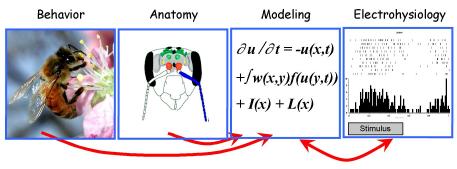
Honeybee Olfaction
 A honeybee may forage on 1,000s of flowers for nectar and pollen in its lifetime. Scent is one of the primary means that it uses for identifying rewarding flowers. How honeybees and other animals learn to associate complex and variable scents with important events is still not well understood. Honeybees are an excellent model system for studying olfaction because their physiology and behavior has been the subject of much research in the past 100 years. Currently, honeybees can be conditioned to associate an odor stimulus with a food reward. After conditioning, honeybees can be tested with many different odors, allowing researchers to identify perceptual similarities among odor stimuli. Additionally, invertebrates are excellent models for studying neurophysiology, and much is known about the honeybee brain.
A honeybee may forage on 1,000s of flowers for nectar and pollen in its lifetime. Scent is one of the primary means that it uses for identifying rewarding flowers. How honeybees and other animals learn to associate complex and variable scents with important events is still not well understood. Honeybees are an excellent model system for studying olfaction because their physiology and behavior has been the subject of much research in the past 100 years. Currently, honeybees can be conditioned to associate an odor stimulus with a food reward. After conditioning, honeybees can be tested with many different odors, allowing researchers to identify perceptual similarities among odor stimuli. Additionally, invertebrates are excellent models for studying neurophysiology, and much is known about the honeybee brain.
Recently, MBI postdoc, Geraldine Wright, and Ohio State University professor, Brian Smith, have pioneered the use of multi-electrode recordings in the honeybee brain during odor stimulation. This technique provides high temporal resolution of the activity of many neurons simultaneously. Using this technique in coordination with behavioral and mathematical modeling studies, it is possible to test specific hypotheses about the way in which the brain encodes information about odors.
At the Mathematical Biosciences Institute, biologists, Geraldine Wright and Brian Smith, have teamed up with mathematicians, Alla Borisyuk and David Terman, to develop mathematical models of the honeybee antennal lobe. The initial work focused on the spatial aspect of odor representation in the honeybee antennal lobe. Two types of models were used for hypothesis testing: a more biophysically-detailed network of spiking cells, and a more abstract model in the form of an integro-differential equation. The results will now be used test specific hypotheses about the role of inhibition in the honeybee antennal lobe using electrophysiology. The electrophysiology, in turn, will drive improvement of the models.
Recently, these models have been extended to analyze the temporal component of odor encoding (grant proposal submitted). The issue of whether the temporal features contribute to odor-coding in the olfactory system is hotly debated in the experimental community, and is a source of many theoretical challenges. Our interdisciplinary team, centered at MBI, is well suited for the task.